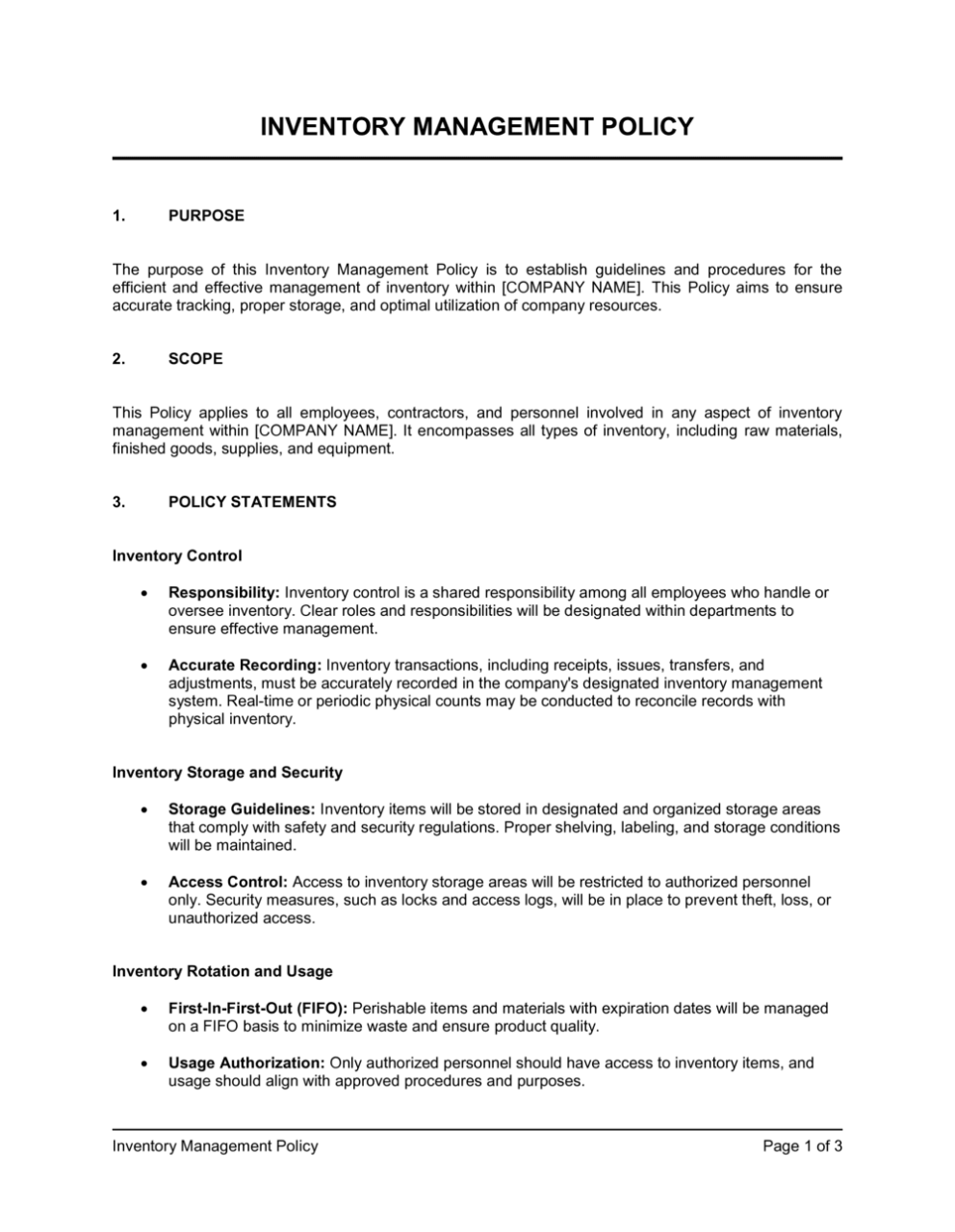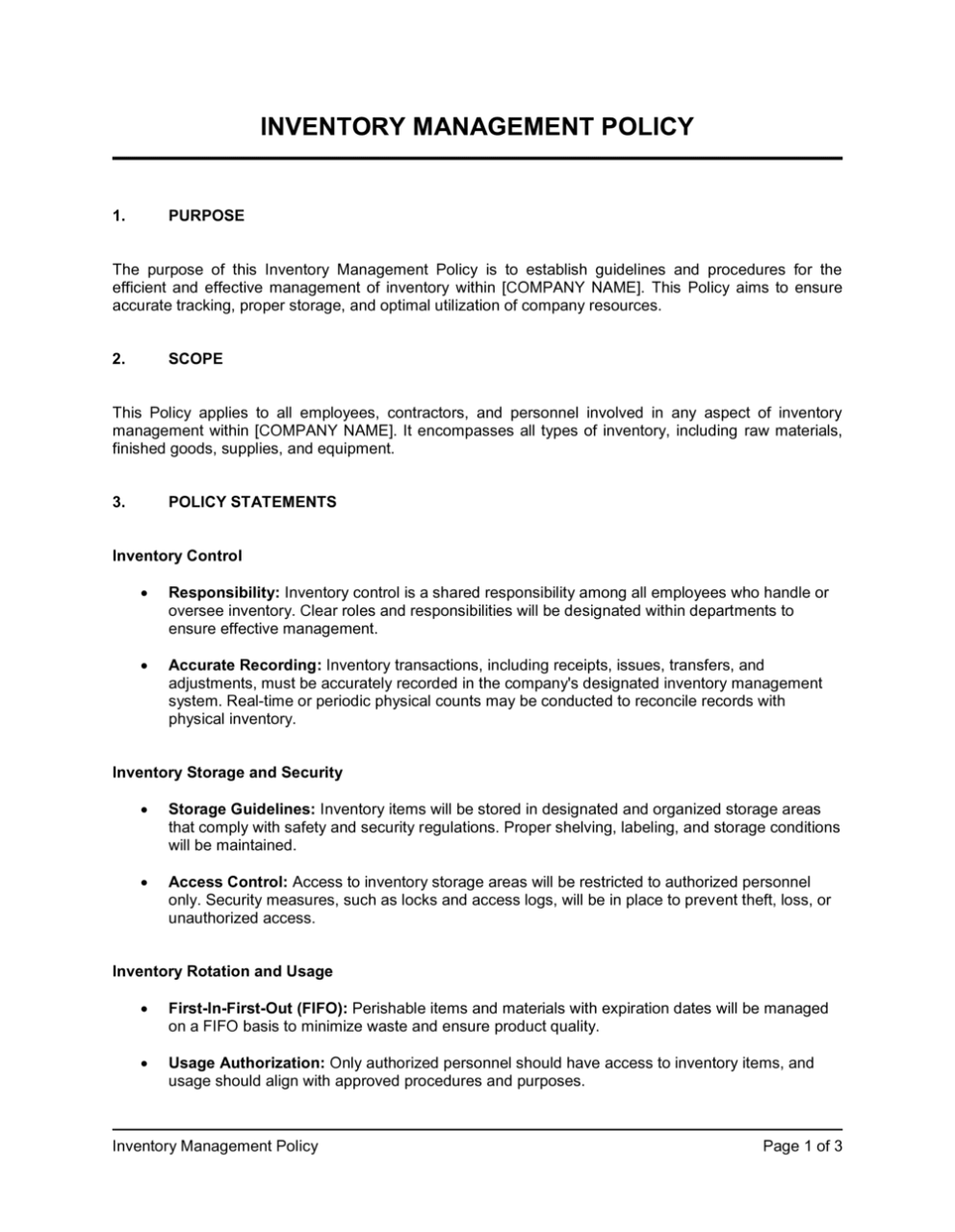
Navigating the Nexus: A Comprehensive Guide to Business Inventory Policies
In the intricate dance of modern commerce, inventory stands as a pivotal asset, a tangible representation of a business’s operational capacity and future sales potential. However, its management is a delicate balancing act, fraught with both opportunities and significant risks. Too much inventory can tie up crucial capital, incur substantial holding costs, and lead to obsolescence, while too little can result in stockouts, lost sales, dissatisfied customers, and production delays. This inherent tension underscores the critical importance of robust business inventory policies.
Business inventory policies are the strategic frameworks and operational guidelines that dictate how a company acquires, stores, manages, and utilizes its inventory across its supply chain. They are the rules that govern when to order, how much to order, where to store, and how to track inventory, all with the overarching goal of optimizing efficiency, minimizing costs, and ensuring customer satisfaction. This article delves into the core objectives, key models, influencing factors, and best practices associated with effective business inventory policies.
The Dual Nature of Inventory: Benefits and Costs
To appreciate the necessity of sound inventory policies, one must first understand the dual nature of inventory itself.
Benefits of Holding Inventory:
- Meeting Customer Demand: The primary reason is to ensure products are available when customers want them, preventing lost sales and maintaining high service levels.
- Economies of Scale: Ordering or producing in larger quantities can lead to lower per-unit costs due to volume discounts or reduced setup costs.
- Buffering Against Uncertainty: Inventory acts as a buffer against fluctuations in demand (unpredictable customer orders) and supply (unexpected delays from suppliers or production issues).
- Hedging Against Price Changes: Businesses might purchase extra inventory to lock in lower prices if they anticipate future price increases.
- Facilitating Production: Work-in-progress (WIP) inventory allows different stages of production to operate somewhat independently, decoupling processes.
Costs Associated with Holding Inventory:
- Holding (Carrying) Costs: These are the costs associated with storing inventory, including warehousing space, utilities, insurance, taxes, security, material handling, depreciation, and the opportunity cost of capital tied up in inventory.
- Ordering (Setup) Costs: These are the costs incurred each time an order is placed or a production run is set up, including administrative costs, transportation, inspection, and machine setup.
- Shortage (Stockout) Costs: These are the most difficult to quantify but potentially the most damaging. They include lost sales, customer dissatisfaction, expedited shipping fees, production delays, and damage to brand reputation.
- Obsolescence and Spoilage: Especially relevant for perishable goods, fashion items, or technology, inventory can lose value or become unusable over time.
Core Objectives of Inventory Policies
Effective inventory policies are designed to achieve a delicate balance between these benefits and costs, focusing on several key objectives:
- Cost Minimization: Reducing the total cost of inventory, which includes ordering, holding, and shortage costs.
- Service Level Optimization: Ensuring that products are available to meet customer demand at a desired service level (e.g., 95% of orders filled on time).
- Operational Efficiency: Streamlining inventory processes to reduce waste, improve lead times, and enhance overall supply chain performance.
- Cash Flow Management: Optimizing the amount of capital tied up in inventory to free up funds for other business investments.
- Risk Mitigation: Protecting the business from supply chain disruptions, demand volatility, and market changes.
Key Inventory Policy Frameworks and Models
Businesses employ a variety of models and approaches, often in combination, to formulate their inventory policies.
1. Quantitative Models:
- Economic Order Quantity (EOQ): This foundational model determines the optimal order size that minimizes the total inventory costs (holding costs + ordering costs). It assumes constant demand, known lead times, and no stockouts. While its assumptions are often idealistic, EOQ provides a valuable baseline for understanding the trade-off between ordering and holding costs.
- Formula (Conceptual): EOQ = sqrt((2 Demand Ordering Cost) / Holding Cost per unit)
- Reorder Point (ROP): This policy dictates when to place an order. It’s calculated by considering the demand during the lead time (time between placing an order and receiving it) plus a safety stock.
- Safety Stock: This is extra inventory held to mitigate the risk of stockouts due to unexpected demand fluctuations or supply delays. Its level depends on demand variability, lead time variability, and the desired service level.
- Fixed Order Quantity (Q) System: Orders a fixed quantity (often EOQ) whenever inventory levels drop to the reorder point.
- Fixed Period (P) System: Inventory levels are checked at fixed intervals (e.g., weekly), and an order is placed to bring the inventory up to a target level. The order quantity varies.
- ABC Analysis: Based on the Pareto principle (80/20 rule), this method classifies inventory items into three categories based on their annual consumption value:
- A-items: High-value, low-volume (e.g., 10-20% of items accounting for 70-80% of value). Require tight control, frequent review, and accurate forecasts.
- B-items: Medium-value, medium-volume (e.g., 30-40% of items accounting for 15-20% of value). Monitored regularly.
- C-items: Low-value, high-volume (e.g., 50-70% of items accounting for 5-10% of value). Simpler controls, larger order quantities, less frequent review.
2. Strategic and Collaborative Approaches:
- Just-in-Time (JIT) / Lean Inventory: Originating from the Toyota Production System, JIT aims to minimize inventory by receiving goods and producing parts only as they are needed. This significantly reduces holding costs and waste but requires highly reliable suppliers, predictable demand, and robust processes.
- Materials Requirements Planning (MRP): A planning and control system for managing dependent demand items (components that go into a finished product). MRP uses a Master Production Schedule (MPS) to calculate the exact quantities and timing of raw materials and sub-assemblies needed.
- Distribution Requirements Planning (DRP): Extends MRP principles to the distribution network, managing the flow of finished goods from central warehouses to regional distribution centers and retail stores.
- Vendor-Managed Inventory (VMI): In VMI, the supplier takes responsibility for managing and replenishing the customer’s inventory levels. This fosters closer collaboration, improves forecast accuracy, and reduces stockouts for the customer, while giving the supplier better visibility into demand.
- Consignment Inventory: Similar to VMI, but the supplier retains ownership of the inventory until it is actually sold or consumed by the customer. This reduces the customer’s working capital needs and inventory risk.
- Multi-Echelon Inventory Optimization (MEIO): For complex supply chains, MEIO considers inventory levels across multiple stages (echelons) – from raw materials to manufacturing, distribution centers, and retail – to optimize the overall network.
Factors Influencing Policy Design
The choice and configuration of inventory policies are not one-size-fits-all. Several factors critically influence their design:
- Demand Characteristics:
- Variability: Stable vs. highly volatile demand. High variability necessitates higher safety stock.
- Seasonality: Predictable peaks and troughs require anticipatory inventory.
- Trends: Growing or declining demand influences long-term inventory planning.
- Life Cycle: New products, mature products, and end-of-life products have different inventory needs.
- Lead Time:
- Length: Longer lead times require higher reorder points and potentially more safety stock.
- Variability: Unpredictable lead times increase the need for safety stock.
- Product Characteristics:
- Value: High-value items require tighter control (e.g., A-items).
- Perishability: Items with short shelf lives (food, pharmaceuticals) require strict FIFO (First-In, First-Out) policies and rapid turnover.
- Size/Weight: Influences storage costs and transportation logistics.
- Supplier Reliability: Reliable suppliers with consistent lead times reduce the need for excessive safety stock.
- Cost Structure: The relative costs of holding, ordering, and potential stockouts directly impact EOQ calculations and safety stock levels.
- Service Level Targets: Higher desired service levels (e.g., 99% fill rate) generally necessitate higher inventory levels, particularly safety stock.
- Supply Chain Complexity: Global supply chains with multiple nodes and partners introduce greater uncertainty and require more sophisticated policies.
- Technological Capabilities: The availability of advanced forecasting software, ERP systems, and real-time tracking (e.g., RFID) enables more precise and dynamic inventory management.
Implementation Challenges and Best Practices
Implementing effective inventory policies is not without its hurdles:
Challenges:
- Forecasting Accuracy: Inaccurate demand forecasts are a primary cause of inventory imbalances.
- Data Integrity: Poor data quality (inaccurate inventory counts, incorrect lead times) undermines policy effectiveness.
- System Integration: Disconnected systems across different departments (sales, production, purchasing) hinder holistic inventory visibility.
- Resistance to Change: Employees may resist new processes or technologies.
- Balancing Conflicting Goals: Sales wants maximum availability, finance wants minimum inventory.
Best Practices:
- Accurate Forecasting: Invest in robust forecasting tools and methodologies, incorporating historical data, market intelligence, and statistical models. Regularly review and adjust forecasts.
- Data Accuracy and Visibility: Implement strong inventory control measures, conduct regular cycle counts or physical inventories, and leverage WMS (Warehouse Management Systems) and ERP (Enterprise Resource Planning) systems for real-time visibility.
- Supplier Relationship Management: Foster strong relationships with suppliers to improve lead time reliability, reduce costs, and explore collaborative strategies like VMI.
- Segmentation and Customization: Don’t treat all inventory items the same. Use ABC analysis and tailor policies to different product categories, customer segments, or demand patterns.
- Technology Adoption: Utilize advanced analytics, AI/ML for predictive modeling, and automation for ordering and tracking to enhance decision-making and efficiency.
- Continuous Monitoring and Adjustment: Inventory policies are not static. Regularly review performance metrics (inventory turnover, stockout rates, carrying costs) and adjust policies in response to changing market conditions, supply chain dynamics, and business objectives.
- Cross-Functional Collaboration: Ensure alignment and communication between sales, marketing, production, purchasing, and finance departments.
- Embrace Agility and Resilience: Design policies that can adapt quickly to unexpected disruptions, building in flexibility and alternative sourcing strategies.
The Role of Technology in Modern Inventory Management
Technology has revolutionized inventory policy implementation. Modern tools enable businesses to move beyond basic spreadsheets and manual processes:
- Enterprise Resource Planning (ERP) Systems: Provide an integrated platform for managing all business processes, including inventory, procurement, sales, and finance, offering a holistic view.
- Warehouse Management Systems (WMS): Optimize warehouse operations, from receiving and putaway to picking, packing, and shipping, improving inventory accuracy and efficiency.
- Advanced Planning and Scheduling (APS) Software: Enhances forecasting, production planning, and inventory optimization with sophisticated algorithms.
- Radio-Frequency Identification (RFID) and Barcoding: Provide real-time, accurate tracking of inventory movement, reducing manual errors and improving visibility.
- Artificial Intelligence (AI) and Machine Learning (ML): Used for predictive analytics to improve demand forecasting, identify optimal safety stock levels, and automate ordering decisions based on complex data patterns.
- Internet of Things (IoT): Sensors can monitor environmental conditions for sensitive inventory or track asset location, adding another layer of control.
Future Trends in Inventory Management
The landscape of inventory management continues to evolve, driven by global complexities and technological advancements:
- Increased Focus on Resilience: Geopolitical events and global disruptions (like pandemics) are forcing businesses to build more resilient supply chains, potentially leading to higher safety stock for critical items or diversified sourcing.
- Sustainability and Circular Economy: Policies will increasingly consider environmental impact, promoting recycling, reuse, and minimizing waste throughout the inventory lifecycle.
- Hyper-Personalization and On-Demand Production: As customer expectations for customization grow, inventory policies will need to support more agile, small-batch production and direct-to-consumer models.
- Predictive and Prescriptive Analytics: AI/ML will become even more sophisticated, not just predicting demand but prescribing optimal actions to manage inventory proactively.
- Blockchain for Transparency: While still nascent, blockchain technology could offer unprecedented transparency and traceability in supply chains, enhancing trust and reducing fraud in inventory management.
Conclusion
Business inventory policies are far more than just operational guidelines; they are a strategic imperative that directly impacts a company’s profitability, operational efficiency, and customer satisfaction. The journey from basic quantitative models to advanced, technology-driven, and collaborative approaches reflects the increasing complexity and criticality of inventory management.
By understanding the inherent trade-offs, adopting appropriate policy frameworks, leveraging technological advancements, and committing to continuous improvement, businesses can transform inventory from a potential liability into a significant competitive advantage. In a dynamic global marketplace, the ability to effectively navigate the nexus of supply and demand through intelligent inventory policies will be a defining characteristic of successful enterprises.


